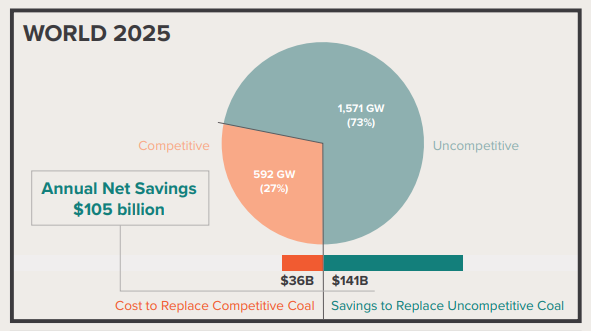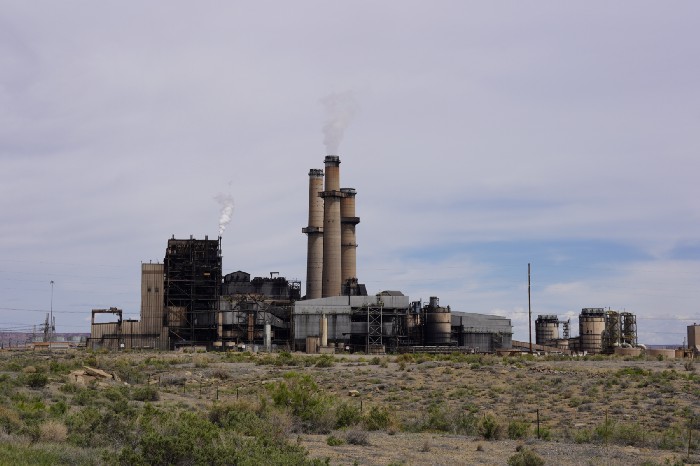How to retire the global coal fleet now — with Coal Phase-out Mechanisms.
by Steven Herz (Sierra Club) and Caroline Ott (Rocky Mountain Institute)
Coal has long been viewed as the cheapest and easiest way to power an economy. But the end of the long reign of “King Coal” is now both essential and inevitable. Essential, because continued reliance on the most carbon intensive energy would condemn us, and the generations after us, to endure a dangerously destabilized climate. And inevitable, because better solutions for our energy needs are readily available, and those solutions are generally cheaper than coal. It is clear that we will stop using this dirty and expensive technology sooner or later; the only question is whether we do it fast enough to avert the worst impacts of climate change.
New analysis by Rocky Mountain Institute, Carbon Tracker Initiative, and the Sierra Club makes clear that the coal “endgame” is already well under way. We found that new renewable energy is now cheaper than new coal plants virtually everywhere, even before considering coal’s dire health, climate, and environmental impacts. And because new coal plants are rarely competitive with new renewables, fewer and fewer plants are getting built.
But even if the world stopped building new coal plants tomorrow, the problem would remain. Existing coal plants spew enough carbon pollution to blow past the Paris Agreement objective of keeping climate change below 1.5°C. To keep this temperature target within reach, global coal use must decline by 80 percent below 2010 levels by 2030. This will require a phase-out in OECD countries over the next decade and in the rest of the world by 2040.

It’s time to hit the OFF switch on coal power. Image: pxfuel.com
Because coal plants are still being built, and because many existing plants are relatively new, we can’t simply wait for plants to close when they reach the end of their useful lives. A lot of plants will need to retire early, long before their owners have recouped their investments.
The rapidly changing economics of the power sector should help smooth this transition. Our study found that almost 40 percent of existing coal capacity worldwide could be replaced today with cheaper new renewables and storage. This number will rise to over 70 percent in 2025, as the cost of both renewable generation and storage continue to fall. And that’s before the health and environmental costs of coal pollution are considered.
In fact, renewable energy and storage are now so cheap that switching the entire world from coal to clean power would pay for itself by 2022, and would save over US$100 billion by 2025. What’s more, replacing uncompetitive coal with clean energy would free up resources to pay for a just transition for workers and communities, and would help reboot economies, create new jobs, improve health, and reduce carbon emissions.

The price tag of replacing the global coal fleet with renewables in 2025: it would save money. Image: RMI/Carbon Tracker/Sierra Club
In a deregulated, competitive market, this might happen almost automatically. Expensive coal can’t survive direct competition with cheaper renewables, and would soon be driven from the grid. But most electricity markets don’t work that way. Over 90 percent of global coal plants are shielded from competition with renewables, either because they have locked customers into long-term contracts or because they operate in tightly controlled markets in which they are monopoly suppliers. As a result, customers may be forced to pay for dirty, expensive and climate destabilizing coal power for years or even decades after it makes economic sense to switch.
Cleverly-designed, Coal Phase-out Mechanisms can help retire these plants early and replace them with clean energy. These mechanisms save customers money by giving them access to cheaper renewables, while enabling everyone to benefit from improved health and reduced climate-related risk. At the same time, they enable coal plant investors to continue to earn a profit by replacing returns from coal investments with returns from clean resources. And they can generate resources to preserve workers’ livelihoods and protect their benefits, and ensure that host communities can continue to thrive.
A Coal Phase-out Mechanism works through an integrated three-part approach:
- Refinance existing coal assets with low cost debt to free up capital.
- Reinvest part of the new capital in clean energy resources that can replace the coal plant — allowing owners and investors to replace their coal returns with clean returns.
- Use part of the new capital to support a just transition for workers and communities.
The approach is already being implemented. For example, the U.S. state of New Mexico securitized a ratepayer surcharge to raise low-cost debt to finance the retirement of a dirty plant, reinvest in clean energy, and support the transition of affected communities. Green bonds can also be used for this purpose.

The San Juan Generating Station coal plant in New Mexico is being retired and replaced by renewables with a Coal Phase-out Mechanism. Image: Steven Baltakatei Sandoval
Governments and public finance institutions — such as green banks, multilateral and national development banks, and development finance institutions — should create Coal Phase-out Mechanisms to help accelerate the retirement of coal power and spur a just transition toward a clean energy future.
Where new clean energy already outcompetes existing coal, it may be possible to achieve all three parts of this package without additional public funds. But where coal remains competitive (ignoring its unpriced health and environmental costs), this three-part approach may require additional public resources in the short term. OECD countries should make these funds available domestically, and should provide them to poorer countries as part of their climate and development assistance.
There are a number of ways governments or public financiers could offer this concessional support for retirements. They could pay a “carbon bonus” for each ton of emissions abated to better reflect the unpriced benefits of transitioning from coal to clean energy, making the economics of coal phase-out more attractive. Or, instead of providing direct payments, the concession could be provided through debt forgiveness or concessional rates on new loans for replacement renewables. In either case, public resources should be allocated through transparent and competitive processes such as reverse auctions to minimize costs.
COVID-19 economic recovery plans provide a unique opportunity to accelerate the coal-to-clean transition. Low-cost debt and public stimulus monies can be used to close plants, invest in replacement renewables and reinvest in coal dependent communities. Or, a “climate bailout” by central banks, as discussed in a previous blog in this series, could generate the required capital. Moreover, by aligning stakeholder interests around voluntary efforts to accelerate coal phaseouts, these measures can help eliminate political opposition and speed up this transition. Given the urgency of both the economic and the climate crisis, the time to start structuring these deals is now.
Read the full “How to Retire Early” report here.
About the series:
The Fossil Endgame blog series is organized by the Leave it in the Ground Initiative (LINGO) in collaboration with the Rapid Transition Alliance (RTA) and supported by the Dutch Committee of the International Union for the Conservation of Nature (IUCN NL).
LINGO works on speeding up the energy transition to 100% renewables, both by supporting frontline struggles against fossil fuel projects and by pushing forward game-changing approaches that can end fossils in years, not decades.
RTA provides evidence-based hope for a warming world. A rapid economic transition, including widespread behaviour change to sustainable lifestyles, is necessary to live within planetary ecological boundaries and to limit global warming to below 1.5 degrees. We gather, share and demonstrate evidence of what is already possible to remove excuses for inaction and show ways ahead.
